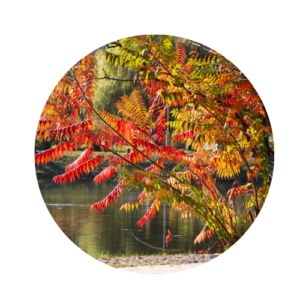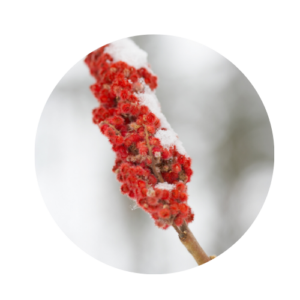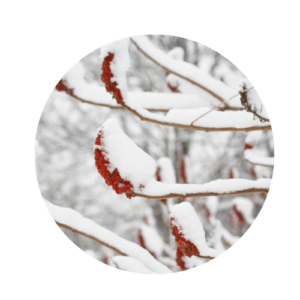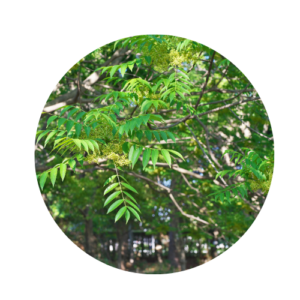Behind the garage was Dad’s woodworking shed where we occasionally helped him with a project and where we schemed and scurried in secretive shifts before Christmas. Under the cheerful red glow of the heat lamp, we could see our breath as we eagerly built each other marble races, wooden sewing blocks, and bead mazes.
Behind the shed was a stand of junipers. Against that shaded back wall, old bricks were stacked haphazardly, and various tools listed as if worn out from decades of service. This served as our workshop where we created lumpy pottery out of mud and practiced making mortar to erect fantastic buildings notwithstanding the few bricks at our disposal.
Behind the juniper stand, a thickly clustered grove of sumac trees extended all the way to the back of the pasture where the fence made a sharp left turn and a string of towering oaks and maples lined the fence until fence and trees disappeared behind the barn far across the pasture.
On one of my first rambles through the pasture, I felt drawn to this diminutive but verdant thicket of sumac. The instant I strode under the green, spreading, featherlike leaves, I came under their spell. I formed a lasting impression of sumacs as magical and ancient. I felt exactly like I had stumbled into “Peter in Blueberry Land” and was strolling beside the king of the forest beneath a canopy of ferns.
The sumacs were my size. I could easily reach many of the lower branches arching from the slim, elegant trunks. I fit in here; I belonged here. I loved to linger under the sumacs, watching the filtered sunlight stream green and sometimes almost purple through this living awning, shadows shifting in unpredictable, mesmerizing displays according to the whims of the breeze.
Standing under the sumacs, I also felt a weight of sorrow and loss that I couldn’t articulate but also couldn’t escape. These trees seemed connected in an inexplicable way to the indigenous peoples who had lived on this land before me. I knew that these specific trees could not be that old, could not have existed before the invasion of European settlers, yet they conveyed an authenticity and authority that seemed as if it could only have come from immediate contact—communion even—with the original peoples who lived here. Sumacs represented to me the beauty of deeply belonging to the land and suggested to me the trauma and tragedy of having been forced away from the land.

I had adored the sumacs in summer, but early fall introduced fresh ecstasies; I was enraptured by the rich colors that suddenly cloaked the sumac—stunning reds and oranges that in the sunlight made each leaf resemble a tongue of flame. There had been nothing like this in Texas. Fall there had been a bleak, brown affair that happened every year, though you couldn’t really have said when. Fall in Virginia is a drama ushered in with a trumpet blast of blazing sumac.
The fiery leaves drifted to the ground to reveal on otherwise bare, skeleton branches fuzzy, red elongated cones composed of tiny almost fluffy red balls. These cones had appeared among the foliage in the summer, and I had inspected and dissected one with relish. They often joined pinecones and juniper berries in baskets foraged for winter.
But in the winter, these cones were the crown of the sumac and the domain of the chickadees who would busily dart among them, their black caps flashing against the red cones in gorgeous contrast. Watching them, I felt exquisite pleasure in knowing that the sumacs, my sumacs, were providing life to these hardy, cheerful birds.

One morning the following spring, I glanced out the porch window at my sumacs and was arrested by the sight of machinery. Along the fence at the back of the pasture, several large cherry-picker trucks were hoisting men with chain saws into the air, and quickly branches were tumbling down. The trees themselves followed. Tall, spreading maples and oaks crashed to the ground amid the debris of their amputated limbs.
Aghast, I appealed to Mom to stop them. She gently told me she couldn’t. A housing development was going to be built behind our field, and the trees were being cleared in order to accommodate the telephone poles and wiring that would be strung behind the houses. The trees were technically not on our property; they actually stood just on the other side of the fence. There was nothing we or our landlord or anyone else could do about it.
I felt nausea well up along with my tears. Helpless rage consumed me as I watched our beloved trees crash to the ground over the course of the week. Bewildered, I grieved and stormed and mourned, unable to witness the destruction but equally unable to tear my eyes away.
Finally, they reached the fence corner and stopped. They couldn’t touch my sumacs. They were on our side of the fence and were too short to be of any consequence to the electrical wires and telephone poles. This was an unspeakable relief in the midst of my sorrow.
I still loved my sumacs and once again gloried in their colors that fall, but from a distance. I rarely ventured to that corner of the pasture any longer. The spirit that had lived there, that had compelled my interest and had instantly captured my imagination when I answered its call, had withdrawn. The sumacs were still beautiful, but the magic was gone.

Many years later, on a Pennsylvania hillside, one side of my yard was lined with sumac.
My daughter was three when we moved there, and I loved that she too could grow up in the shade of the sumacs. They saw her march behind my lawnmower in the summers, proudly pushing her doll’s stroller in my freshly mown tracks, her popsicle-stained lips chatting cheerfully although I couldn’t hear her over the roar of the mower. In the fall, they saw her on Sunday afternoons sporting her tiny pink and white Polamalu jersey and knitted Steelers hat, deftly managing takeaways and making touchdowns.
During the long, dreary winters along the backbone of the Alleghenies, she and I watched through frosted windows as birds flocked to the sumacs to wrest a little strength from their beautiful, red cones. I was glad to observe that, to the chickadees, sumacs will always be magical—offering rest and giving life even in a barren land.

Rachel Brown
enjoys sipping tea, savoring good books, and spending time outside.
She is daily inspired to live more deeply and love more fully by her husband and two children.

One Response
I love your thoughts and memories! They ignite my own and cause me to appreciate even more your incredible memory, vivid word choices, and life lessons learned. Some people paint with pigments and brushes….you paint with words!